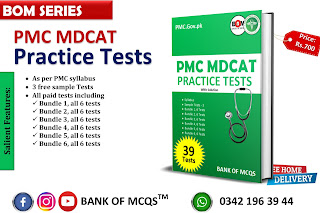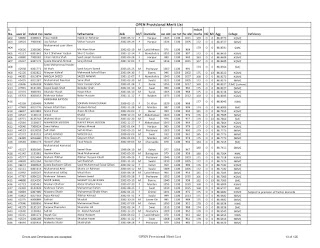ALL PHYSICS FORMULAS total 300 formulas
ALL
PHYSICS FORMULAS
Measurements
1. Smallest
unit of measurement by;
Measurement tape → 1 cm
or 1mm
Meter rule or half
meter rule → 0.1 cm or 1 mm
Vernier caliper → 0.01
cm or 0.1 mm
Screw gauge → 0.001 cm
or 0.01 mm
2. θ
= s/r
3. 2π
rad = 3600
4. 3600
= 1 revolution
5. 1
radian = 57.30
6. 1
degree = 60 minute
7. 1
minute = 60 seconds
8. Angle
at circle is 2π radian.
9. Angle
at sphere is 4π steradian.
10. Volume
of slid cylinder = πr2l
11. Area
of sphere = 4πr2
12. Volume
of sphere = 4/3 πr3
13. Dimension
of velocity = [LT-1]
14. Dimension
of acceleration= [LT-2]
15. Energy
of photon; E = hf
16. Time
period of pendulum; T = 2π 
Vectors and
equilibrium
17. Commutative
property of vector= A+B = B+A
18. Fx
=F cosθ
19. Fy
= Fsinθ
20. F
= 
21. A.B
= AB cos θ
22. A
x B = AB sin θ
23. Scalar
product; work and power
24. Vector
product; torque
25. τ
= r x F
26. First
condition of equilibrium; ∑F = 0
27. Second
condition of equilibrium; ∑τ = 0
Motion and Force
28. v
= s/t
29. a
= v/t
30. vf
= vi +at
31. s
= vit + ½ at2
32. 2as
= vf2 – vi2
33. S
= vave x t
34. Vave
=( vi + vf )/2
35. g
= 9.8 ms-2 = 32 ft-2
36. F
= ma
37. a
= v/t
38. P
= mv
39. P
= F t
40. Impulse;
J = F x t = ∆P
41. J
= ∆P
42. Law
of conservation of momentum; ∆p = 0
43. Elastic
collision in one dimension; [v1 + v2] = [v1’+
v2’]
44. Magnitude
of projectile velocity; Vf = 
45. Height
of projectile; H = vi2sin2θ/2g
46. Time
of flight; T = 2 vi sinθ/g
47. Time
of summit or time to reach to highest point; T = vi sinθ/g
48. Range;
R = vi2 sin 2θ/g
49. Rmax
= vi2/g
50. R
= Rmax at 450
Work and Energy
51. W
= Fd cosθ
52. Power;
p=W/t or p =Fv
53. 1
watt = Js-1
54. 1
hp = 746 watts
55. K.E
= ½ mv2
56. P.E
= mgh
57. Efficiency
= output/input = W x D/P x d
58. Absolute
potential energy =Fr = - GmMe/Re (- because work is done
against gravity)
59. Gravitational
potential = E/m = GMe/Re
60. For
escape velocity compare K.E with Absolute potential energy; vesc =  → vesc =
→ vesc = 
61. G
= 6.67 x 10-11 Nm2kg-2
62. Re
= 6.4 x 106 m
63. Me
= 6 x 1024 kg
64. Vesc
= 11.2 x 103 ms-1
65. Wh
= K.E + fh → (Wh = loss in potential energy)
66. Loss
in P.E = Gain inn K.E + work done against friction
67. E
= mc2 →(c= 3 x 108 ms-1)
Rotational and
circular motion
68. Angular
velocity; ω = ∆θ/∆t
69. Angular
acceleration; α = ∆ω/∆t → a = α x r
70. v
= r ω
71. Fc
= mv2/r
72. ac
= -(v2/r)
73. Centrifugal
force= mv2/r
74. F
sin θ = mv2/r
75. F
cos θ = mg
76. Tan
θ = v2/gr
77. Τorque
= r F = rma = rm (rα) =( r2m)α = I α
78. Moment
of inertia; I = mr2
79. Ring
or thin walled cylinder inertia(I) = MR2
80. Disc
or solid cylinder inertia = ½ MR2
81. Disc
inertia = ½ M (R22 + R12 )
82. Solid
sphere inertia = 2/5 MR2
83. Solid
rod or meter stick inertia = 1/12 Ml2
84. Rectangular
plate inertia = 1/12 M (a2+b2)
85. Angular
momentum = L = r x p = r mv = rmrω =r2mω = Iω
86. L
= rmv → L/t = rmv/t = rma = rF = τ
87. L/t
= τ
88. Linear
kinetic energy = ½ mv2
89. Rotational
kinetic energy = ½ Iω2
90. Velocity
of hoop = v = 
91. Velocity
of disc = v = 
92. Critical
velocity = v = 7.9 km2
93. The
orbital velocity = v =
94. Lift
at rest → T =w
95. Lift
moving downward → T = w – ma
96. Lift
moving upward → T = w + ma
97. Lift
falling freely = T mg-ma = 0
98. Frequency
for artificial satellite → f = 
Fluid dynamics
99. Drag
force → Fd = 6 πη r v
100. Terminal
velocity → vt = 
101. Continuity
equation → A1 v1 = A2 v2
102. Av=∆V/∆t
= constant
103. ∆m/∆t
= ρ ∆V/∆t
104. Bernoulli’s
Equation = P + ½ ρv2 + ρgh = constant
105. Torricelli’s
Theorem → v = 
106. Flow
meter or the venture meter → v1 =
Oscillation
107. Frequency
→ f=1/T
108. Angular
frequency → ω = 2πf
109. Time
period → T = 2π/ω
110. Velocity
of projection → vy = ω
111. Simple
pendulum time period → T = 2π 
112. Simple
pendulum potential energy = ½ kx2
113. Simple
pendulum kinetic energy = ½ kx02 -½ kx2
114. Total
energy of simple pendulum = ½ kx02
115. Resonance
frequency = Fn = nf1
116. Phase
→ θ =ω t
Waves
117. Transverse
wave speed → 
118. Longitudinal
waves speed → 
119. Phase
change→ 2π = λ
120. Phase
difference → δ = 2π/λ
121. Speed
of sound by newton → v =  = 281 ms-1
= 281 ms-1
122. Laplace
correction → v =  = 332 ms-1
= 332 ms-1
Chap No.11 ELECTROSTATICS
123. 1 e =
1.602 x 10-19 C
124. Q = ne
125. Coulomb’s
Law; F = k

126. K = 
127. K = 9.0
x 109 N m2 C-2
128. εo
= 8.85 x 10 -12 C2 N-1 m-2
129. εr
= 
130. Fmed
= 
131. E =  =
=  =
K
=
K 
132. Ф = E A
cos θ = N m2 C-1
133. Ф = 
134. E due
to sheet of charge; E = 
135. E due
to charge palates; E = 
136. V =  =
=  Volt = Joule /
Coulomb
Volt = Joule /
Coulomb
137. Electric
potential energy; U = 
138. Electric
potential; V =  =
=  =
= 
139. Potential
Gradient = E = -

140. 1 eV
=1.602 x 10-19 C x 1V
→ (1 eV = 1.602 x 10-19
J)
141. C =  =
C V-1 = farad
=
C V-1 = farad
142. Charge
density; σ = 
143. Cvac
=  =
=  =
= 
144. εr
= Cmed / Vvac
146. Capacitors
In Series;
147. Q = Q1
= Q2 =Q3
148. V =V1 +
V2 + V3
149. 1/Ce =
1/C1 + 1/C2 + 1/C3
150. Capacitors
In Parallel;
151. Q = Q1
= Q2 = Q3
152. V = V1
+ V2 +V3,
153. Ce = C1
+ C2 + C3
154. Electric
dipole; P = q d
155. Energy
= U =  =
= 
 (Ed)2
(Ed)2
156. Energy
density;  E2
E2
157. Maximum
charge on capacitor = C x e.m.f
158. q/q0
= 63.2 % →for charging
159. q/q0
= 36.7 % →for discharging
160. q = q0
(1-e-t/RC ) →for
charging
161. q = q0
e-t/RC →for
discharging
Chap No. 12 CURRENT ELECTRICITY
162. Current,
I = Q/t → C s-1 = A
163. Drift
velocity order = 10-5 m/s.
164. V
= IR
165. Tan
θ = I/V = 1/R
166. Resistance,
R = V/I → 1Ω = 1V/1A
167. R
= ρ L/A → Ω.m
168. Conductance,
G = 1/R → Siemen(S) or mho
169. Conductivity,
σ = 1/ρ =L/RA →mho/m or S/m
170. Pure
metals R inc with T inc.
171. Electrolytes
and insulators, R dec with T inc.
172. ΔR
= αR0 T → RT = R0 (1+αT)
173. Temperature
co-efficient of Resistance, α = RT – R0/R0T → K-1
174. Resistivity,
ρ T = ρ 0 (1+αT) OR α
= ρ T – ρ 0/ ρ 0T → K-1
175. Electromotive
Force, ε = W/q → 1 volt = 1
joule/coulomb
176. Open
circuit, I = 0 so V= ε
177. Terminal
Voltage, Vt = ε - Ir
178. Power, P = W/t = VI → 1 Watt = 1V x 1A
179. 1
kWh = 1 unit of electrical energy
180. 1
J = 1W x 1s
181. Maximum
output power, (Pout)max
= ε2 /4r = ε2 /4R
182. Thermo
emf, ε = αT + ½ βT2
183. KCL,
ƩI = 0
184. KVL, Ʃε = ƩV = ƩIR
185. KCL
based on L.O.C.O.CHARGE
186. KVL
based on L.O.C.O.ENERGY
187. Wheatstone
Bridge, X = PQ/R
188. Potentiometer, ε2 /ε1 = I2
/I1
189. Tan
θ = I/V = 1/R
Chap No. 13 ELECTROMAGNETISM
190. Force
on current carrying wire, F=BIL sin θ.
191. Magnetic
field or magnetic induction, B = F/IL →1 tesla =1 NA-1 m-1
= 1 Wb m-2
192. 1
T = 104 G
193. Magnetic
Flux, Ф = B A cos θ → 1 Wb = 1 N m A-1.
194. Ampere’s
Law, B  I/r = μ0 (I/2πr) OR
ƩB.ΔL = μ0 I
I/r = μ0 (I/2πr) OR
ƩB.ΔL = μ0 I
195. Bnet
= B1 + B2
196. Magnetic
field due to current carrying solenoid,
B = μ0 n I → n=N/L
197. Motion
of charge particle in uniform magnetic field,
F=q v B sin θ
198. Centripetal
Force = Magnetic force → mv2/r
= qvB
199. Time
period of charge particle in B, T
= 2πm/qB
200. Frequency
of charge particle in B, f = qB/2πm
201. Velocity
selector, FE = FM → qE
= qvB → v = E/B
202. Torque
on current carrying coil, τ = NBIA cos
θ
203. Ρestoring
torque, τ = C θ
204. Galvanometer, NBIA cos θ = C θ → I = Cθ/NAB → I  θ
θ
205. Conversion
of galvanometer into ammeter, small R
connected in parallel
206. Conversion
of galvanometer into voltmeter, large
R in series are connected
207. Ammeter, Rs = Rg Ig /
(I – Ig) → Ideal ammeter
→ 0 R
208. Voltmeter, Rh = (V/Ig) – Rg → Ideal voltmeter →
infinite R
Chap No. 14
ELECTROMAGNETIC INDUCTION
209. Faraday’s
Law, ε  N (ΔФ/Δt)
→ ε = N (ΔФ/Δt )
N (ΔФ/Δt)
→ ε = N (ΔФ/Δt )
210. Lenz
Law, ε = –N (ΔФ/Δt )
211. Flux
motional emf, ε = Blv sin θ
212. Rate
of work done, W= Bilv
213. Rate
of production of electrical energy,
energy =ε I
214. W
= energy → Bilv = εI → ε = Blv
215. Power, P = F
v
216. ε
= L ΔI/Δt or ε = N ΔФ/Δt → LI = NФ
217. Self-Inductance, L = NФ /I
218. ε
= M ΔI/Δt or ε = N ΔФ/Δt → MI = NФ
219. Mutually
inductance, M = NФ /I
220. F
= 1/T
221. Induced
emf, ε = NAB cosωt or
NAB ω sinωt
222. ε
= εmax sin ωt
223. Back
emf, V = ε + IR
224. Ns
/ Np = Vs / Vp = Ip /Is
Chap
16 PHYSICS OF SOLIDS
225. Elastic
modulus = 
226. Tensile
stress = 
227. Tensile
strain = 
228. Young
modulus =  = Nm-2
= Nm-2
229. Shear
stress = 
230. Shear
strain =  = tan θ
= tan θ
231. Shear
modulus = rigidity modulus =  =
= 
232. Bulk
or volume stress = 
233. Bulk
modulus (in fluids) = Δp = 
234. Volume
strain =- 
235. Bulk
modulus =  =
= 
236. Stress
 strain (Hook’s law)
strain (Hook’s law)
237. A
=  r2
r2
238. W
= ½Fe (work done on stretching wire).
239. Strain
energy = ½ F e
240. Strain
energy per unit volume = 
 = ½ (stress) (strain )
= ½ (stress) (strain )
Chap 18 DAWN OF MODERN PHYSICS
241. E
= m0 c2
242. L=
L0 
243. T
= t0 
244. M
= m0 
245. λmax
T = 0.2898 x 10-2 m k
(Wein’s displacement law)
246. E
= σ T4 (Steffan-Bolts
Law)
247. σ
= 5.67 x 10-8 Wm-1 K-4
248. E
= n h f
249. K.Emax
= e V0
250. K.Emax
= h f – Ф
251. H
f0 = Ф = 
252. K.Emax
= hf - Hf0
253. Hf
= K.E +hf’
254. P=

255. Δλ
= 1-
1-
256.  =
=  +
+  1-
1-
257. Ephoton
= Eelectron + Epositron
258. Photon
rest mass energy = 2m0c2 = 1.02 MeV
259.  = mve-
+ mve+
= mve-
+ mve+
260. λ
=  =
= 
261. Δp
=  and Δx = λ
and Δx = λ
262. (Δp)(Δx)
= h
263. (ΔE)(Δt)
= h
Chap
19 ATOMIC SPECTRA
264.  = R (
= R (  -
-  )
)
265. R
=E0 / hc = 1.097 x 107m-1.
266. mvr
= nh/2π.
267. h
= planks constant = 6.6256 x 10-34 j s.
268. E
= hf = En – Ep
269. rn
= 
270. En
= - 
271. En
= = 2.17 x 10-18 j/ n2 =
+13.6 ev/ n2
= 2.17 x 10-18 j/ n2 =
+13.6 ev/ n2
272. rn = n2 r1 → r1 =
0.53 0A.
273. 1
0A = 10- m
274. 2πr=nλ
275. eV
→ hfmax = hc/λmin
276. λmin
= hc/eV
277. excited
state for 10-8 s.
278. metastable
state for 10-3 s
Chap
20 NUCLEAR PHYSICS
279. Nuclear
size is of the order of 10-14 m.
280. The
mass of the nucleus is of the order of 10-27 kg.
281. ½
mv2 = Vq
282. Bqv
= mv2/r
283. Bqv
= mv2/r → m = Bqr/v
284. ½
mv2 = Vq → v2 = 2Vq/m
285. So
m = qr2B2/2V
286. Δm
= Zmp + Nmn – M(A,Z)
287. The
binding energy in MeV is 931 x Δm.
288. The
binding energy per nucleon = Eb/A.
289. 0n1
→ 1H1 + -1β0 + antineutrino 12 MIN
290. ΔN/Δt
=-λN
291. R
=- ΔN/Δt =λN
292. N=
N0e-λt
293. 1
Bq = 1 decay per second
294. 1
Ci = 3.70 x 1010 decay/s
295. λT
½ = 0.693
296. The
charge on u,t and c, in term of electron is +2/3e.
297. The
charge on s,t and b in term of electron is -1/3e.
298. proton
=2U→D.
299. neutron =U ←2D







